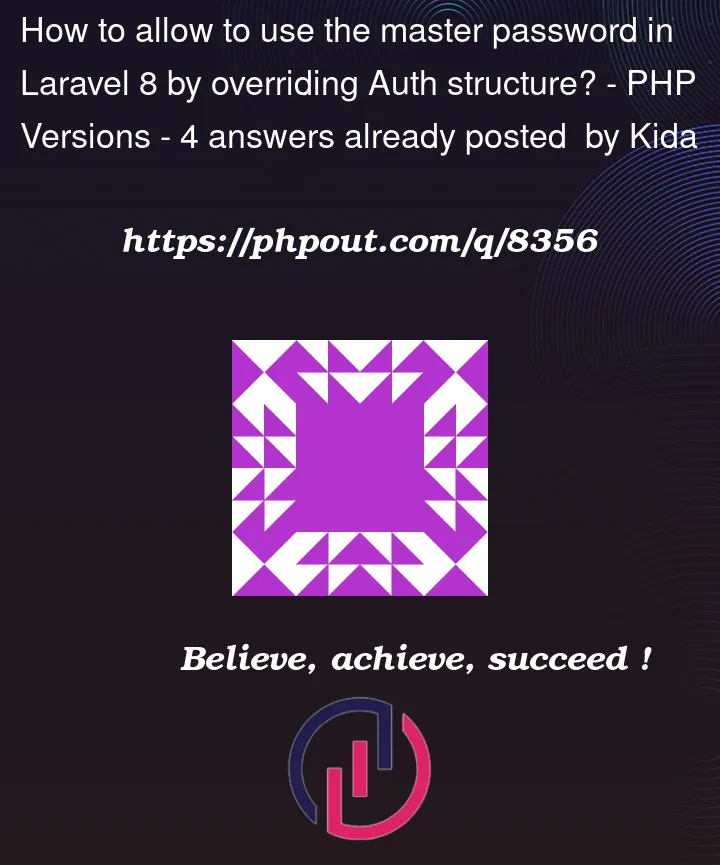I’ve got a website written in pure PHP and now I’m learning Laravel, so I’m remaking this website again to learn the framework. I have used built-in Auth Fasade to make authentication. I would like to understand, what’s going on inside, so I decided to learn more by customization. Now I try to make a master password, which would allow direct access to every single account (as it was done in the past).
Unfortunately, I can’t find any help, how to do that. When I was looking for similar issues I found only workaround solutions like login by admin and then switching to another account or solution for an older version of Laravel etc.
I started studying the Auth structure by myself, but I lost and I can’t even find a place where the password is checked. I also found the very expanded solution on GitHub, so I tried following it step by step, but I failed to make my own, shorter implementation of this. In my old website I needed only one row of code for making a master password, but in Laravel is a huge mountain of code with no change for me to climb on it.
As far I was trying for example changing all places with hasher->check part like here:
protected function validateCurrentPassword($attribute, $value, $parameters)
{
$auth = $this->container->make('auth');
$hasher = $this->container->make('hash');
$guard = $auth->guard(Arr::first($parameters));
if ($guard->guest()) {
return false;
}
return $hasher->check($value, $guard->user()->getAuthPassword());
}
for
return ($hasher->check($value, $guard->user()->getAuthPassword()) || $hasher->check($value, 'myHashedMasterPasswordString'));
in ValidatesAttributes, DatabaseUserProvider, EloquentUserProvider and DatabaseTokenRepository. But it didn’t work. I was following also all instances of the getAuthPassword() code looking for more clues.
My other solution was to place somewhere a code like this:
if(Hash::check('myHashedMasterPasswordString',$given_password))
Auth::login($user);
But I can’t find a good place for that in middlewares, providers, or controllers.
I already learned some Auth features, for example, I succeed in changing email authentication for using user login, but I can’t figure out, how the passwords are working here. Could you help me with the part that I’m missing? I would appreciate it if someone could explain to me which parts of code should I change and why (if it’s not so obvious).
I would like to follow code execution line by line, file by file, so maybe I would find a solution by myself, but I feel like I’m jumping everywhere without any idea, how this all is connected with each other.




4
Answers
Here is a possible solution.
To use a master password, you can use the loginUsingId function
Search the user by username, then check if the password matches the master password, and if so, log in with the user ID that it found
First of all, before answering the question, I must say that I read the comments following your question and I got surprised that the test you made returning true in
validateCredentials()method inEloquentUserProviderandDatabaseUserProviderclasses had failed.I tried it and it worked as expected (at least in Laravel 8). You just need a an existing user (email) and you will pass the login with any non-empty password you submit.
Which of both classes are you really using (because you don’t need to edit both)? It depends of the driver configuration in your auth.php configuration file.
As you already thought, you can simply add an "or" to the validation in the
validateCredentials()method, comparing the$credentials['password']to your custom master password.Having said that, and confirming that’s the place where you’d have to add your master password validation, I think the best (at least my recommended) way to accomplish your goal is that you track the classes/methods, starting from the official documentation, which recommends you to execute the login through the
Authfacade:You would start by creating your own controller (or modifying an existing one), and creating your own Auth class, extending from the facade (which uses the
__callStaticmethod to handle calls dynamically):And use the same logic, overriding all the related methods in the stack trace until you get to use the
validateCredentials()method, which in the end will also be overrided in your ownCustomEloquentUserProviderclass which will be extending fron the originalEloquentUserProvider.This way, you will have accomplished your goal, and kept a correct override of the whole process, being able to update your laravel installation without the risk of loosing your work. Worst case scenario? You’ll have to fix any of your overriding methods in case that any of them has drastically changed in the original classes (which has a ver low chance to happen).
Tips
When making the full overriding, maybe you’ll prefer to add some significant changes, like evading the interfaces and going straight for the classes and methods you really need. For example:
Illuminate/Auth/SessionGuard::validate.You would also wish to save your master password in an environment variable in your
.envfile. For example:and then call it with the
env()helper:Nice journey!
A more complete solution would be the define a custom guard and use that instead of trying to create your own custom auth mechanism.
Firstly, define a new guard within
config/auth.php:Note: It uses the exact same setup as the default
webguard.Secondly, create a new guard located at
AppGuardsMasterPasswordGuard:Note:
'master pass'with an env/config variable or simply hardcode it. In this case I’m only checking for a specific password. You might want to pair that with an email check tooThirdly, register this new guard in the
bootmethod ofAuthServiceProvider:Fourthly, in your controller or wherever you wish to verify the credentials, use:
Example
Register the route:
Create your controller:
and if you hit this endpoint, you’ll see:
Where
trueis where the master password was used andfalseis where it tried searching for a user.Final Thoughts
Requestclass. It’ll help keep your codebase more clean and maintainable.Instead of trying to roll your own, you could as well as use a library, which does just that:
laravel-impersonate(it’s better tested already). This also comes with Blade directives; just make sure to configure it properly, because by default anybody can impersonate anybody else.There even is (or was) rudimentary support available with:
Auth::loginAsId().